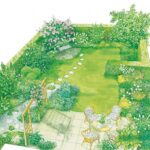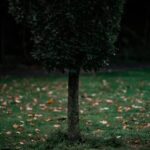Garden design ideas for small gardens present a unique set of challenges and opportunities. With limited space, it can be a creative endeavor to make the most of every inch while still creating an inviting and beautiful outdoor area. From maximizing vertical space to selecting the right plants, there are numerous techniques and strategies to transform a small garden into a stunning oasis.
When it comes to designing a small garden, one of the key considerations is how to make the most of the space available. Whether you have a tiny urban balcony or a compact backyard, there are endless possibilities for creating a charming outdoor retreat. This article will explore various garden design ideas for small spaces, offering inspiration and practical tips for maximizing your outdoor area.
From utilizing trellises and vertical gardens to creating illusions of space with strategic plant placement and mirrors, there are countless ways to enhance a small garden. Additionally, incorporating seating areas, outdoor dining spaces, and multi-purpose features can add functionality and charm to even the tiniest of gardens. Join us as we delve into the world of small garden design, uncovering the secrets to transforming limited space into an enchanting outdoor sanctuary.
Maximizing Vertical Space
When it comes to garden design ideas for small gardens, maximizing vertical space is key to making the most of limited square footage. With the right techniques and tools, small garden spaces can be transformed into lush, green oases that feel much larger than they actually are. By utilizing trellises, hanging planters, and vertical gardens, gardeners can create a visually stunning and functional outdoor space.
Trellises
Trellises are an excellent way to add vertical interest to a small garden. These structures not only provide support for climbing plants such as vines, flowers, and vegetables but also create a sense of height in the garden. Whether installed along a wall or standing freely in the garden bed, trellises can help maximize space by drawing the eye upward.
Hanging Planters
Hanging planters are another fantastic option for small gardens. These containers can be suspended from pergolas, overhangs, or even tree branches to add greenery without taking up valuable floor space. Additionally, hanging planters can be used to grow herbs and other edible plants, providing both beauty and functionality in a compact design.
Vertical Gardens
For those looking to take full advantage of vertical space in their small gardens, vertical gardens are an ideal solution. These innovative systems allow plants to grow vertically along specially designed structures or living walls. Whether using pocket planters or modular panels, vertical gardens offer endless opportunities for creativity and customization in a limited area.
Incorporating these elements into a small garden design can help create an enchanting outdoor retreat that feels spacious and inviting. With the use of trellises, hanging planters, and vertical gardens, even the tiniest of outdoor spaces can become a vibrant and flourishing haven for nature lovers.
Container Gardening
When dealing with a small garden space, container gardening can be a game-changer. This technique allows for flexibility and creativity in the arrangement of plants, as well as the ability to move them around as needed. When considering garden design ideas for small gardens, it’s essential to make the most out of every inch of space available, and container gardening provides a solution to this challenge.
One key benefit of container gardening is that it allows for the cultivation of plants that may not typically thrive in the limited soil space of a small garden. From herbs and flowers to dwarf fruit trees and vegetables, the possibilities are endless when it comes to what can be grown in containers. This opens up a world of opportunities for adding variety and color to a small garden.
In addition to being practical, container gardening also serves an aesthetic purpose. The use of different-sized pots and planters can add visual interest and depth to the garden design, creating an inviting and charming outdoor space. By carefully selecting containers that complement the overall style and theme of the garden, it’s possible to achieve a cohesive look that enhances the beauty of small outdoor areas.
| Container Gardening Benefits | Container Gardening Aesthetics |
|---|---|
| Flexibility and creativity | Visual interest and depth |
| Variety in plant selection | Creating an inviting outdoor space |
Creating Illusions of Space
When it comes to garden design ideas for small gardens, one of the most effective strategies is to create illusions of space. By using mirrors, pathways, and strategic plant placement, you can make your garden appear larger and more inviting.
Mirrors are a powerful tool in small garden design. Placing a mirror at the end of a pathway or along a wall can create the illusion of depth and space. It also reflects light, making the garden feel brighter and more open. When using mirrors in the garden, it’s important to consider their placement to avoid creating glare or reflecting unattractive elements.
Incorporating winding pathways into your small garden can also make it feel larger than it actually is. Curved paths add visual interest and lead the eye around the space, creating the feeling of exploration. By obscuring parts of the garden from immediate view, pathways can also give the impression that there is more to discover beyond what meets the eye. Additionally, using materials like gravel, stepping stones, or wood chips for pathways can add texture and charm to the garden.
Strategic plant placement is another essential aspect of creating illusions of space in small gardens. Using a mix of tall and short plants can add layers and depth to the garden, while grouping plants in clusters rather than spacing them out individually can make the area feel lush and full.
It’s important to consider scale when choosing plants for a small garden – oversized or sprawling plants may overwhelm the space, while smaller or compact varieties are better suited for limited areas.
| Strategy | Description |
|---|---|
| Mirrors | Reflect light and create an illusion of depth |
| Pathways | Add visual interest and lead the eye around the space |
| Plant Placement | Add layers and depth to the garden with strategic groupings |
Optimal Plant Selection
When it comes to garden design ideas for small gardens, choosing the right plants is crucial. In a limited space, it’s important to select plants that will thrive without requiring excessive maintenance. Low-maintenance options such as succulents, dwarf shrubs, and ornamental grasses are perfect for small gardens, as they require minimal care while still adding beauty and interest to the space.
In addition to low-maintenance plants, incorporating space-saving varieties can help maximize the available area in a small garden. Consider vertical gardening with climbing plants, which can grow upward instead of spreading outwards.
This not only saves precious ground space but also adds height and dimension to the garden. Compact or dwarf versions of popular plants like roses, hydrangeas, and fruit trees are also great choices for small gardens, as they provide all the beauty and benefits of their full-sized counterparts without taking up as much room.
Another approach to optimal plant selection in small gardens is choosing plants that serve multiple purposes. For example, selecting edible plants like herbs or compact vegetables not only adds greenery and texture to the garden but also provides a practical function by yielding fresh produce. This functional design approach maximizes the usefulness of the limited space while still creating an aesthetically pleasing environment.
The key to successful plant selection in small gardens is thoughtful consideration of each plant’s needs and characteristics. By choosing low-maintenance options, space-saving varieties, and multipurpose plants, gardeners can create beautiful and practical outdoor spaces even in limited areas.
Functional Design
When it comes to garden design ideas for small gardens, functionality is key. Creating a space that serves multiple purposes while still maintaining an inviting atmosphere can be a challenge, but with the right approach, it is entirely possible. Here are some tips for incorporating seating areas, outdoor dining spaces, and multi-purpose features into your small garden:
- Implement built-in seating: Consider adding built-in benches or seating walls along the edges of your garden. Not only does this provide ample seating for guests, but it also saves space compared to traditional outdoor furniture.
- Opt for collapsible or stackable furniture: If you prefer the flexibility of movable furniture, choose options that can easily be folded or stacked when not in use. This allows you to maximize space and create a more open layout when needed.
- Create a designated dining area: Even in a small garden, it’s possible to carve out a dedicated space for outdoor dining. Whether it’s a cozy bistro set tucked into a corner or a simple picnic table that can double as a workspace during gardening projects, having an area specifically for eating enhances the functionality of the space.
- Incorporate multi-purpose features: Look for ways to make your garden elements serve dual functions. For example, a planter box could also function as a dividing wall between different sections of the garden, or an arbor could provide both shade and support for climbing plants.
By focusing on functional design in your small garden, you can create a space that not only looks beautiful but also serves your practical needs. With careful planning and strategic choices, you can make the most of every square inch and transform your garden into a versatile retreat.
Lighting and Ambiance
When it comes to garden design ideas for small gardens, lighting and ambiance can play a crucial role in transforming a compact outdoor space into a cozy and inviting retreat. By carefully considering the use of creative lighting, colors, and texture, you can enhance the atmosphere of your small garden and make it a delightful place to spend time in.
Creative Lighting
One of the key elements in creating ambiance in a small garden is the use of creative lighting. From string lights and lanterns to solar-powered stake lights and LED spotlights, there are numerous options for adding an enchanting glow to your outdoor space. Consider incorporating different types of lighting to create depth and visual interest, such as overhead string lights for a magical effect or low-level pathway lights to guide the way.
Colors and Texture
Incorporating color and texture into a small garden can make a big impact on its overall ambiance. Choose plants with vibrant blooms or foliage to add pops of color throughout the space. Introduce textures through materials such as wooden benches, stone pathways, or decorative gravel. Additionally, consider adding colorful outdoor textiles like cushions and throws to seating areas for a cozy and inviting feel.
Creating Ambiance
To create an inviting atmosphere in your small garden, think about how you want to use the space. Whether it’s for relaxing with a book, entertaining friends, or enjoying al fresco dining, incorporate elements that cater to these activities.
For example, add comfortable seating with soft cushions or invest in a bistro set for intimate dining. By addressing the functionality of your garden design with regards to ambiance creation, you can ensure that it becomes an enjoyable extension of your living space regardless of its size.
By focusing on lighting and ambiance in your small garden design plan, you can elevate the overall atmosphere of your outdoor space and transform it into an enchanting oasis. Whether it’s through creative lighting choices, strategic use of colors and textures, or planning for specific activities within the space – these elements have immense power in making even the smallest gardens feel welcoming and charming.
Designing for Year-Round Interest
When designing a small garden, it’s essential to create a space that remains visually appealing throughout the year. With limited square footage, every plant and design element should serve a purpose in maintaining interest and beauty in the garden. Here are some clever design choices to ensure year-round interest in small gardens:
- Planting Evergreen Shrubs and Trees: Incorporating evergreen plants into the garden provides a sense of continuity and structure, especially during the winter months when other plants may go dormant. Some excellent options for small gardens include boxwoods, dwarf conifers, and holly bushes.
- Introducing Seasonal Blooms: Selecting a variety of plants that bloom at different times of the year ensures there’s always something colorful and eye-catching in the garden. From spring-blooming bulbs like daffodils and tulips to summer perennials like daylilies and coneflowers, strategic planting can create a constantly changing landscape.
- Incorporating Ornamental Grasses: Ornamental grasses add movement, texture, and visual interest to the garden, even during the colder months. These low-maintenance plants come in a range of sizes and colors, providing year-round appeal with minimal effort.
By carefully selecting plants that offer seasonal interest and incorporating elements like evergreen trees, seasonal blooms, and ornamental grasses, small gardens can remain enticing throughout all seasons. Additionally, creating focal points with unique sculptures or architectural features can also contribute to maintaining year-round interest in these compact outdoor spaces.
Remember that designing for year-round interest doesn’t have to be complicated or overwhelming; with thoughtful planning and creative plant selection, small gardens can become captivating havens no matter the time of year.
Conclusion
In conclusion, designing a small garden may present unique challenges, but with the right approach, it can also offer endless opportunities for creativity and innovation. From maximizing vertical space to selecting the optimal plants and creating illusions of space, there are countless ways to transform a compact outdoor area into a beautiful retreat. By incorporating functional design elements, creative lighting, and thoughtful plant selection, small gardens can become inviting and visually appealing spaces that can be enjoyed year-round.
The key takeaway from this exploration of garden design ideas for small gardens is that size should never limit the potential of an outdoor space. With the use of clever techniques such as vertical gardening and container gardening, it’s possible to create lush and vibrant landscapes even in limited areas. By embracing the principles outlined in this article and infusing personal style and preferences into the design process, anyone can turn their small garden into a captivating oasis.
Whether you’re looking to enhance your existing small garden or starting from scratch with a new space, there are endless possibilities for creating a stunning outdoor retreat. By considering the tips and ideas presented here, readers can embark on a journey of transforming their small garden into a place of beauty, relaxation, and inspiration. With the right approach and attention to detail, even the smallest outdoor area can become a cherished sanctuary for both its owners and visitors alike.
Frequently Asked Questions
How Do I Design a Small Garden Idea?
When designing a small garden, it’s important to start by considering the space you have and what you want to achieve with it. Think about the functionality, aesthetic, and maintenance of the garden. Incorporating vertical gardens, using raised beds, and choosing the right plants can maximize the space.
How Do You Arrange Plants in a Small Garden?
To arrange plants in a small garden, consider their height, spread, and color to create visual interest. Group plants with similar water and sunlight needs together. Utilize containers to add variety and flexibility in arranging your plants. Remember to leave some empty spaces for growth and movement.
How Do You Layout a Garden Design?
When laying out a garden design, start by mapping out the different areas like pathways, seating areas, and plant beds. Consider focal points like trees or sculptures that can anchor the design. Balance different elements such as color, texture, and scale throughout the layout while keeping in mind your overall vision for the garden.

Welcome to my gardening blog! I am passionate about plants and enjoy sharing my knowledge and experiences with others. In this blog, I will write about everything related to gardening, from tips on how to get started to updates on my own garden projects.





